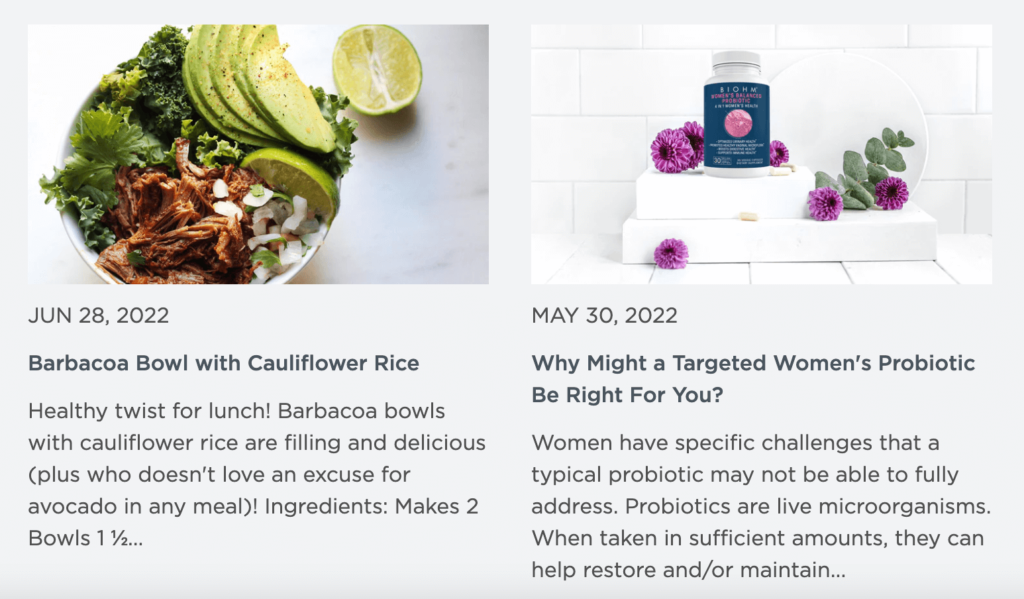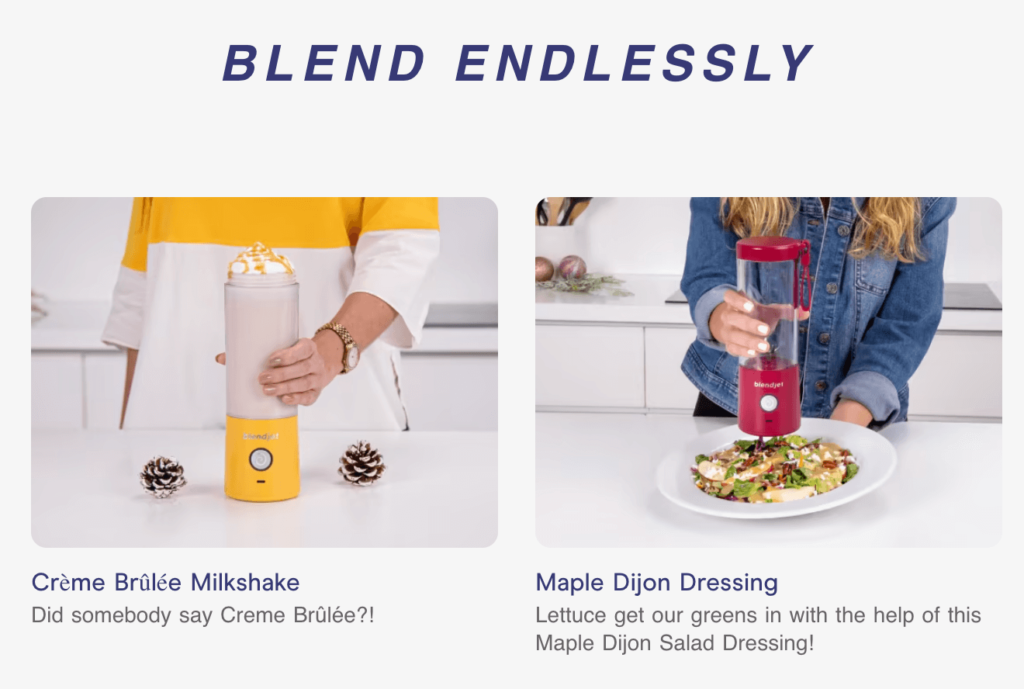In this first post of our new content series, we’re sharing all the tips and inspiration you need to create a blog that not only serves your subscribers, but can also help you bring in new customers. Throughout this series, we’ll be exploring the various types of content that merchants should create, depending on their business goals and target audience.
Blogs have been around for decades at this point, and with newer forms of content like social media taking a front seat, you might be wondering if a blog still serves a purpose. We’re here to tell you that yes, blogs are alive and well (as we share this on…a blog). Merchants shouldn’t discount the value a blog can bring to their brand and the ways in which it can support their subscribers.
Key takeaways
- A blog can be used as a reliable platform for sharing information with both current and future customers.
- Blog content should be created with a specific audience and goals in mind.
What are blogs?
The term blog comes from the word “weblog,” or a webpage used to share information and business content. It’s a webpage dedicated to sharing blog posts, each having a title and copy, and often a handful of photos to support the written content. Typically, there’s room at the end for readers to leave comments if they’d like.
The purpose of a blog varies—it can be informative, fun, useful, etc. The content is often driven by business goals. Do you want to provide your customers with helpful information about your projects? Or would you like to share customer success stories to increase trust in your brand?
Whatever your goals are, they can be achieved by a blog that’s updated often and full of well-written posts and content that supports your products or services.
Who is the typical audience of blogs?
It’s hard to define a particular audience of blogs—the answer will vary depending on the type of blog you have. With social media and other platforms, it’s easier to define age ranges and specific groups of users. With blogs, it’s more important to define who your target audience is, then ensure you create content that will resonate with them.
Defining your target audience
So, before you can start creating your blog, it’s crucial to define your target audience so you can create the right kind of posts. To define this group, start by analyzing your customer data. Take a look at factors like age, location, gender, and shopping habits. How did they find your company? How do they already engage with your shop and any other platforms you’ve created?
Identifying their demographics in this way will help you create an ideal customer profile (ICP), allowing you to shape your content on fictional customers who have the same qualities as your real customers.
5 tips for starting your blog
Once you’ve defined your target audience and ICPs, you can get started creating your blog. Of course, you’ll need to come up with content ideas that will satisfy your readers, and bring value to their subscription experience. Any way in which you can enrich your products or services with these bonuses—like educational or informational blogs—can naturally encourage subscribers to stick around longer.
1. Decide your goals
Just like it’s crucial to define your audience, it’s also important to identify clear goals that will drive your content. A blog can be valuable both for your subscribers and for your business, in that you can create content that serves your customers but also creates trust and recognition for your brand and has the potential to bring in new customers.
The content you provide can certainly enrich the customer experience, leading to longer customer lifespans with your business. And, if it allows you to bring in new customers, that’s even better—especially considering today’s rising customer acquisition costs.
Let’s look at an example. Say you offer a product that’s used in the kitchen. Maybe your blog will be full of recipes that utilize your kitchen tool and offer tips on cooking with it. This would support a goal of offering valuable content to your customers, while also providing a natural way for new customers to find your brand. They might be searching for recipes or kitchen tips and come across your product, leading to a purchase—or at the very least, increased awareness of your brand.
2. Brainstorm content ideas
So, you have a target audience, and you have your goals on what you want your blog to accomplish. Now it’s time to come up with content ideas. Whether you have a dedicated writer on your team or need to outsource your posts, you’ll want to create a content calendar so you can post blogs at a regular cadence. This way, your readers know what to expect and you can stay consistent.
Blog content ideas can come from anyone at your company—in fact, it’s a great idea to source blog topics from teams outside of your marketing organization. Customer service team members can give you great insight into common questions your subscribers are asking, and product team members can help you share information that could be useful to customers.
It’s also a great idea to think of a few series ideas that would be appealing to your target audience and run with them. For example, if you run a candle company, you could create a series of blogs that show how customers can repurpose their candle jars after use, offering them step-by-step instructions and photos on how to reuse these vessels instead of discarding them.
3. Strategically consider your voice
Your company has probably already established a brand voice, used in communication like emails, on your website, and on social media. Continuing this brand voice in your blog posts, but adjusting it slightly for the nuances of this format, is essential for creating an overall brand image that’s cohesive and trustworthy.
When you think about tone, it’s also important to consider your audience. What kind of words are they using? How do they speak? Keeping copy concise is important too, no matter what demographic you’re aiming to please.
4. Use enticing imagery
Though it may be hard to accept, the truth is that attention spans are getting shorter and shorter, especially among the younger generations. Not only will it benefit you to keep copy to the point, but it’s also a great idea to include images that support your message. Adding in photos or graphics within your blog posts will make them more enticing and interesting to read.
5. Share blog posts through other channels
Once you’ve published your blogs, it’s smart to cross-promote them on other channels. This will help you gain traffic to your blog, making it more likely that the right readers will find the valuable content you’re creating. You can share new blogs posts in:
- Social media posts
- Email newsletters
- Online communities
- Partner communications
- Customer portals
Blog inspiration: Recharge merchants who are winning the blog game
Now that you have the basics of blogging down, let’s take a look at some Recharge merchants who have really harnessed the power of the blog. These merchants understood the value they could bring to their subscription community with a blog by sharing content relevant to their audience and enriching the customer experience along the way.
Bokksu
The Bokksu blog is a great example of using your blog as an extension of your brand. Bokksu creates authentic Japanese snack boxes, with their main audience being those who love Japanese culture. Their blog reflects that—it’s full of posts on Japanese traditions, arts, and other cultural aspects that their customers will find interesting.

BIOHM Health
For merchants with products in the Health & Wellness realm, having an informative blog can make the difference between a purchase and losing a customer. BIOHM Health does a great job of creating a blog that’s helpful for both current and prospective customers, answering frequently asked questions and providing advice for those using their probiotics or other products.

BlendJet
Another great use of your blog can be to encourage customers to use your product. This is the case for BlendJet, maker of the original portable blender. There’s really only one use for a blender—to make smoothies, salad dressings, milkshakes, and other liquid creations. For this reason, BlendJet has created a blog that’s entirely filled with recipes. Customers don’t even have to leave the website to know exactly how to use their blender, and what to make with it.

Creating a successful blog for your subscribers
Determining the right kind of content to focus on, that will bring value to your brand and be useful to customers, is crucial. We hope this series is helpful to merchants looking to expand or improve their current content channels and create platforms that make their customer experience more expansive for their subscribers.
Sources
[1] CAC (customer acquisition cost) (Recharge ecommerce glossary)



